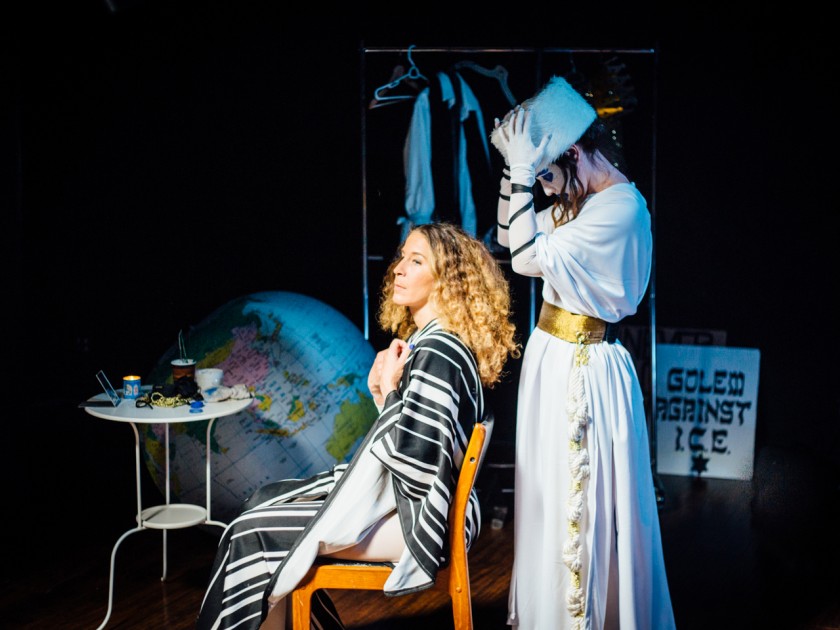
Golem v. Golem, created by Julie Weitz (Dir. D.S. Chun and Co-Dir. Julie Weitz), 2021, (Photo Credit Alex the Brown)
THE CAST: the Simple Child, the Wicked Child, the Wise Child, the Child Who Does Not Know How to Ask
SCENE
The waiting room of the Jewish Community Foundation Center of Greater Levittsonville. On the wall is a poster of two joyful children planting a tree in the Negev desert. Three people are sitting as far away from each other as possible. One, MATTHEW, wears a tweed jacket, and a shirt tucked into khaki slacks. His hair is neatly combed, save for a few strands poking out on either side. He is holding a copy of The Jerusalem Report, dated 1994, but seems unable to focus on reading. He is bouncing his left leg rapidly. The second, MARKY, slouches on the opposite side of the room, his legs splayed open. He is also wearing a suit jacket, and an untucked polo shirt underneath. He has an earpiece in one ear, and a heavy beat can be heard emanating from it. He is gripping a Frappuccino in one hand, and is scrolling rhythmically on his iPhone 9 or 10 with the other. The third, nearest the door, M., is dressed in all black, and is writing in a notebook balanced on one leg; a book by C. L. R. James, open and facedown, is balanced on the other. M. stops writing, takes a packet out of black canvas bag, and begins to roll a cigarette.
On the door, there is a handwritten sign: “Welcome: Community information-gathering session about the Golem!!”
The door opens. A JCFC staff member in a gray suit walks out, holding a clipboard.
JCFC STAFF MEMBER: Matthew Cohn, M. Pinsky-Appelbaum, and, um, Marcus-Aurelius Millor? Come on in, we’re ready to see you.
–
This piece is a companion literary response to Julie Weitz’s Golem V. Golem, produced by Asylum Arts for Dwelling in a Time of Plagues, made possible with the generous support of CANVAS. In 2017, in response to the Charlottesville protests, Artist Julie Weitz created her performative project My Golem, which centers on her embodiment of the mythical creature drawn from Jewish folklore. A futuristic highly-stylized figure covered with white mud, she was brought to life to respond to contemporary challenges including climate catastrophe, white supremacy, antisemitism and xenophobia.
The project is presented at the Vilna Shul, Boston’s Center for Jewish Culture in partnership with the Jewish Arts Collaborative. Additional digital partners include the Contemporary Jewish Museum in San Francisco, Jewish Museum Milwaukee and the Jewish Museum of Florida-FIU. The work is part of a North American project – Dwelling in a Time of Plagues – a coast-to-coast Jewish artistic response to contemporary plagues. To see the other works on display, visit plaguedwelling.com.
–
A Passover supplement produced for Dwelling in a Time of Plagues, including ten authors and ten artists responding to ten modern plagues, can be downloaded here. Contributing authors include Sarah Blake, Marra B. Gad, Ayelet Gundar-Goshen, Letty Cottin Pogrebin, Rebecca Soffer, Rabbi Abby Stein, Darin Strauss, Michael Twitty, Rabbi Dr. Shmuly Yanklowitz, and Moriel Rothman-Zecher.
Moriel Rothman-Zecher is the author of the novel Sadness Is a White Bird (Atria Books, 2018), which was a finalist for the Dayton Literary Peace Prize and the National Jewish Book Award, among other honors. His second novel, which follows two Yiddish speaking immigrants from a fictional shtetl to Philadelphia of the 1930s, is forthcoming from Farrar, Straus and Giroux. Moriel’s work has been published in The New York Times, the Paris Review’s Daily, Zyzzyva Magazine, and elsewhere, and he is the recipient of the National Book Foundation’s ‘5 Under 35’ Honor, two MacDowell Colony Fellowships for Literature (2017 & 2020), and a Wallis Annenberg Helix Project Fellowship for Yiddish Cultural Studies (2018−2019). Moriel lives in Yellow Springs, Ohio, with his family.
Moriel is the creator of the fictional characters Mathew L. Cohn, Marky Miller, and M. Pinsky-Appelbaum as part of the series, What We Talk About When We Talk About the Golem.